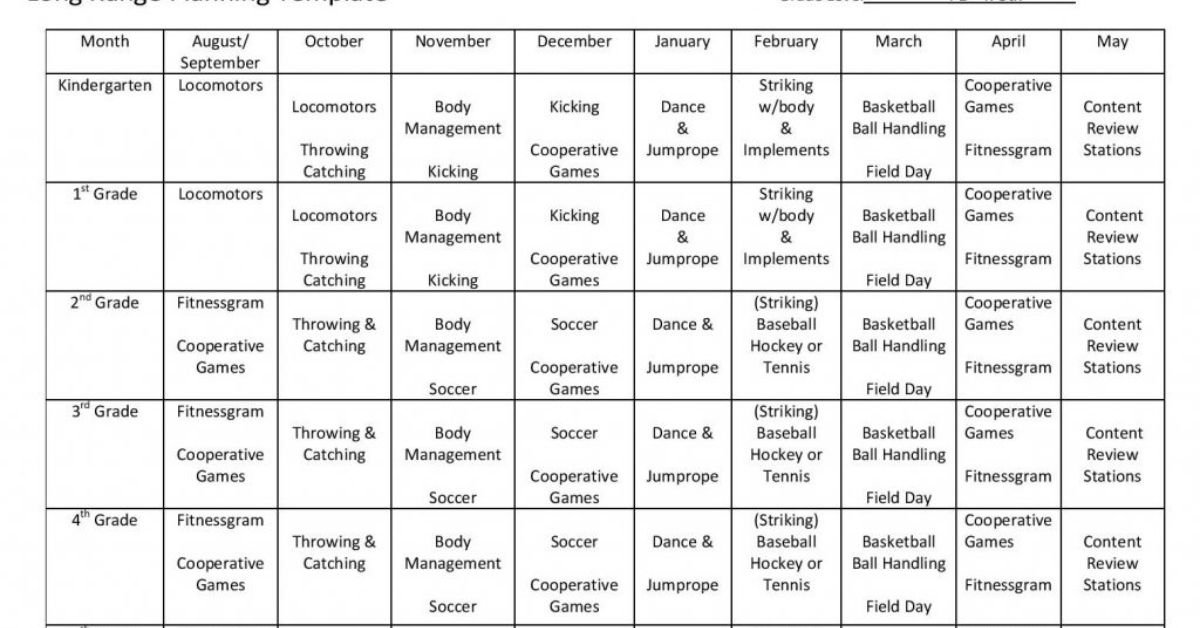A well-designed Physical Education Schedule Routine is essential for fostering students’ physical health, fitness, and overall well-being. This routine not only encourages regular physical activity but also instills lifelong healthy habits. Schools that implement structured physical education programs often observe positive outcomes in both physical and mental health among students. The goal is to create a balanced routine that addresses various aspects of fitness, including cardiovascular health, strength, flexibility, and coordination.
Importance of a Structured Physical Education Routine
Establishing a structured physical education routine is crucial for several reasons:
- Regular Exercise: A consistent schedule ensures that students engage in physical activity regularly, which is vital for their health.
- Academic Performance: Studies indicate that students who participate in daily physical activities tend to perform better academically due to improved focus and concentration.
- Holistic Development: A comprehensive routine contributes to the overall development of students by promoting physical, social, and emotional growth.
By prioritizing physical education within the school curriculum, educators can significantly enhance the quality of education and student outcomes.
Components of an Effective Physical Education Routine
An effective Physical Education Schedule Routine should encompass a variety of activities that cater to different fitness components. Key elements include:
- Aerobic Exercises: Activities like running, jumping, and dancing improve cardiovascular health.
- Strength Training: Exercises such as push-ups and resistance training build muscle strength.
- Flexibility Exercises: Stretching routines help prevent injuries and improve overall flexibility.
- Sports and Games: Engaging in team sports fosters teamwork, communication skills, and strategic thinking.
Incorporating these components ensures a well-rounded approach to physical education that addresses the diverse needs of students.
Time Allocation for Physical Education
Proper time allocation is vital for maximizing the benefits of physical education. The World Health Organization recommends that children engage in at least 60 minutes of moderate to vigorous physical activity daily. Schools should integrate this requirement into their weekly schedules by:
- Daily PE Classes: Allocating specific times each day for physical education to ensure consistent participation.
- Extended Sessions: Offering longer sessions once or twice a week to allow for more in-depth skill development and activities.
By prioritizing time for physical education, schools can help students meet their daily activity goals effectively.
Setting Fitness Goals for Students
Establishing clear fitness goals is essential for motivating students and tracking their progress. Schools can implement the following strategies:
- Weekly Goals: Set short-term objectives focused on specific skills or endurance improvements (e.g., running a certain distance).
- Monthly Goals: Encourage students to achieve broader objectives that reflect their overall progress (e.g., mastering a new sport).
- Personalized Plans: Allow students to create individual fitness plans based on their interests and abilities, promoting ownership of their health journey.
These goal-setting practices not only enhance motivation but also foster a sense of accomplishment among students.
Customizing Routines for Different Age Groups
Different age groups require tailored approaches to physical education. A well-rounded routine should consider the developmental stages of students:
Primary Students
For younger children in primary grades, the focus should be on developing fundamental motor skills through playful activities. Activities may include:
- Tag Games
- Obstacle Courses
- Basic Coordination Drills
These game-like activities promote a positive perception of physical education and encourage participation.
Middle School Students
As students transition into middle school, they should be introduced to more structured sports and activities. This stage can include:
- Team Sports: Such as basketball, soccer, or volleyball.
- Individual Fitness Goals: Allowing students to set personal challenges related to fitness or skill development.
This approach helps develop teamwork skills while encouraging personal responsibility for fitness.
High School Students
High school routines should focus on more advanced training techniques and personal fitness plans. Key components may include:
- Strength Training Programs
- Endurance Activities
- Elective Classes: Such as yoga or dance that cater to individual interests.
Encouraging high school students to take ownership of their fitness journey prepares them for lifelong health habits.
Mental Health Benefits of Physical Education
Physical education plays a significant role in enhancing mental health among students. Regular participation in physical activity leads to various psychological benefits:
- Stress Reduction: Exercise releases endorphins that help alleviate stress and anxiety.
- Improved Mood: Physical activity is linked to elevated mood levels and increased self-esteem.
- Social Skills Development: Team sports foster social interaction and cooperation among peers.
By prioritizing mental health alongside physical fitness, schools can create a supportive environment conducive to overall well-being.
Planning an Annual Physical Education Schedule
Creating an effective annual schedule for physical education requires careful planning. Educators can follow these steps:
- Long Range Plan: Outline the entire year on one page, detailing units of instruction by grade level.
- Monthly Calendar Integration: Incorporate important school dates such as holidays or testing days into the schedule.
- Unit Planning: Develop specific units around relevant themes or sports seasons (e.g., basketball during winter).
This strategic planning allows educators to maintain continuity throughout the year while adapting lessons based on student needs.
Engaging Students Through Varied Activities
To keep students engaged during physical education classes, it is essential to incorporate a variety of activities. Strategies include:
- Choice Modules: Allowing students to select from different units or sports based on their interests.
- Skill Development Sessions: Focusing on two complementary skills within a single class period (e.g., dribbling followed by shooting in basketball).
- Fitness Themes: Introducing weekly themes focusing on specific components of fitness (e.g., flexibility week).
By diversifying activities, educators can maintain student interest while promoting comprehensive skill development.
Conclusion
A well-structured Physical Education Schedule Routine is vital for promoting student health and wellness in schools. By incorporating various activities tailored to different age groups, setting achievable goals, and emphasizing mental health benefits, educators can create an enriching environment conducive to lifelong fitness habits. Investing time in planning an effective routine pays off not only in terms of improved physical health but also in enhanced academic performance and overall student well-being.




